In the middle of July last summer I found myself with no responsibilities. I had five days with no plans and no kids to attend to. I packed AANAR, my modified Herreshoff Coquina, with camping gear and drove from my home in the small town Porvoo to my favorite place to launch, the southern point of Emäsalo Island on the Gulf of Finland. Being by the open sea, the wind there is steady and unobstructed, making sailing faster and more pleasant than in the 10-mile-long inlets that flank Emäsalo. I launched AANAR and rigged her for sailing. The original Coquina was a cat-ketch and with rope steering; mine is rigged with single lugsail and tiller steering. The Wizard of Bristol gave her delicate and fast lines, and she is rewarding to sail.
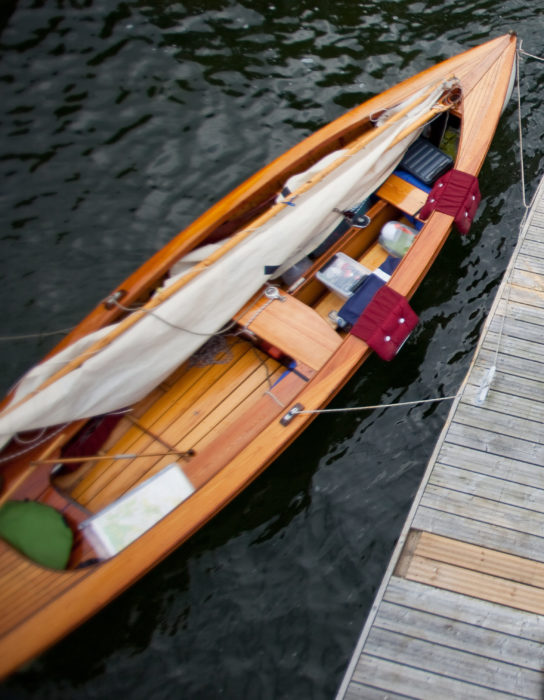 all photographs by the author
all photographs by the authorAANAR’s cockpit has plenty of room for a solo sailor and cruising gear. The burgundy cushions hanging over the side decks are an innovation I tried, hoping to make seat cushions do double duty as fenders. They were, frankly, more comfortable to sit on before the modification.
After setting sail, it took just a few minutes to get out of the bay and around the sheltering Fagerudden cape. Once I had passed the rugged red granite cliffs and boulder-strewn shoreline of Haxalö Island, I had a broad view to south into the vast Gulf. After the hassles of getting groceries and packing charts, clothes, and camping gear, I was finally by the open sea and AANAR’s cream-colored sail was pulling steadily beneath a patchwork of brilliant white clouds and blue sky. While the forecast did not promise sunshine, it did offer light winds, smooth seas, and good sailing. I am comfortable in AANAR with full sail up to 14 knots wind, and when reefed down have done some crossings in sheltered waters safely with 17 to 20 knots.
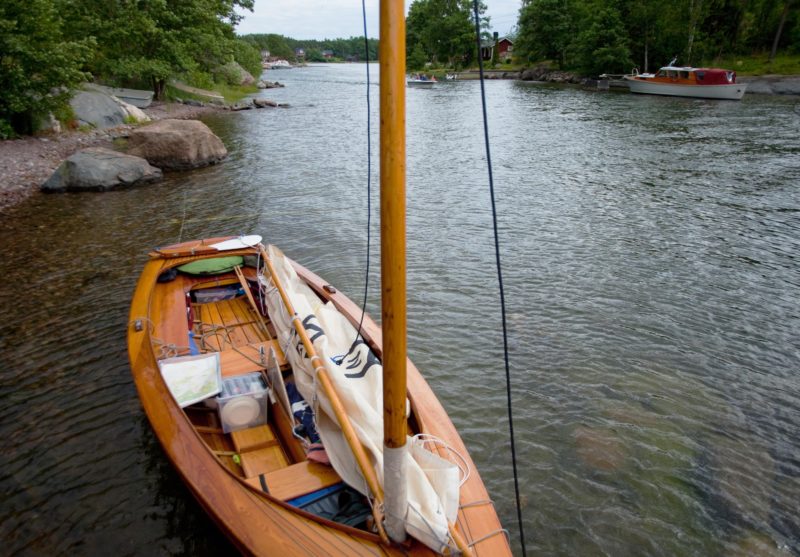
This narrow channel leads into the bay by Pirttisaari, a village that has been inhabited from the beginning of 16th century. While fishing is the main occupation for islanders. the island has two artillery stations that are part of Finnish defenses.
The 5-mile crossing east from the southernmost tip of Emäsalo to the Pellinki archipelago is wide open, but with the wind being gentle and on a broad reach, the sailing was easy and peaceful with little waves only gently rocking AANAR. In the tranquil atmosphere I could step away from the rush to get launched and give myself over to the tranquility of the island-fringed waters. The wind simmered down after my crossing, and I continued slowly eastward through more sheltered waters. Scattered clouds blocked the sun and cast patchwork shadows on the sea and surrounding islands. With the 3-mile-wide Pellinki island slipping by to port, I headed for the island of Sandön, its forest a dark green line on the eastern horizon.
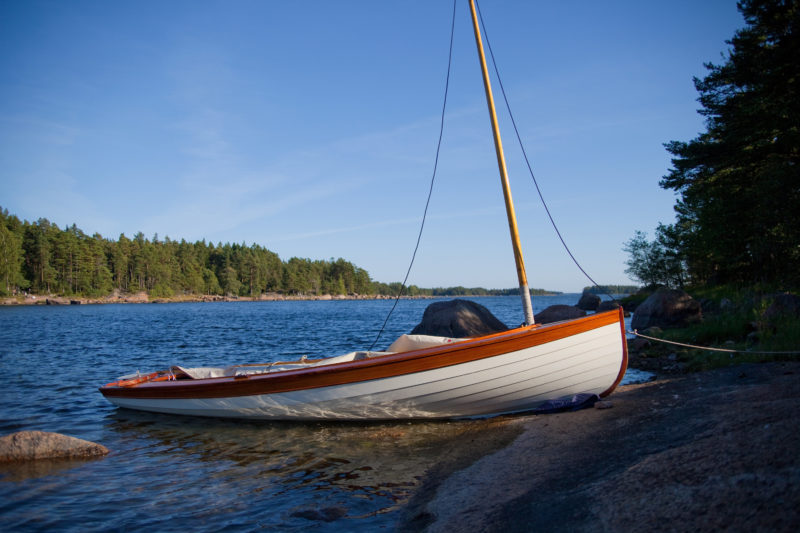
There are no noticeable tides in the Gulf of Finland, and the fluctuations in the sea level that come with wind and changes in barometric pressure are gradual and rarely more than 15″. In a sheltered bay AANAR can rest safely while pulled up on the rocks with just a pad under her bow.
When I approached the shallow west beach of one of Sandön’s coves, AANAR was headed for a scattering of rocks breaking the calm surface of the sea, so I dropped the sail and paddled slowly closer. I found a spot where the grass came almost right down to the water, steered the bow into it, and pulled AANAR upon on a gently sloping sandy beach. I found a flat patch of grass the size of my pop-up tent. Angling under cast-iron gray clouds, rays of sun lit a sea surrounded by the dark silhouettes of nearby islands.
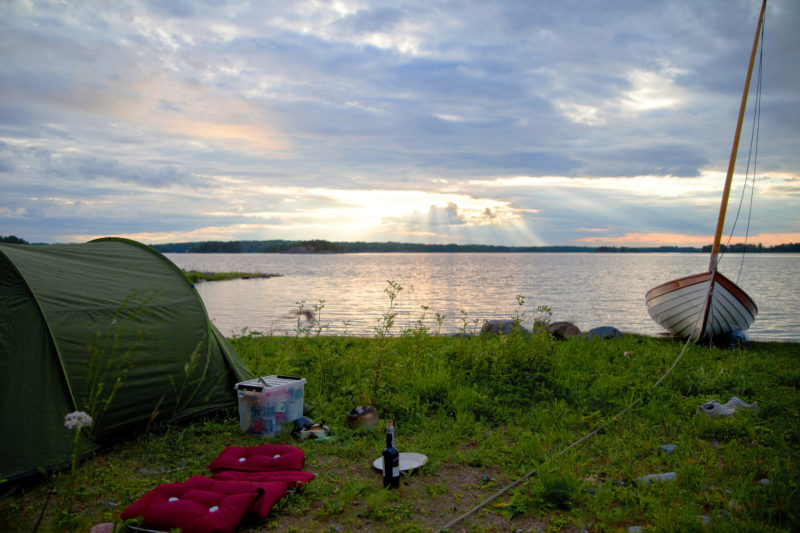
After landing on Sandön, I set up camp with a pop-up tent, a kitchen in a box, boat cushions as a divan with a view, and a bottle of wine.
June and early July had been exceptionally cold, and there were only a few other boats in this popular northwest-facing cove lined with old, crooked pine trees growing a few paces up from the water’s edge. A family of barnacle geese with black necks and white masks swam by, occasionally dipping their heads underwater looking for food. The only sound was the lapping of ripples on the stony shore.
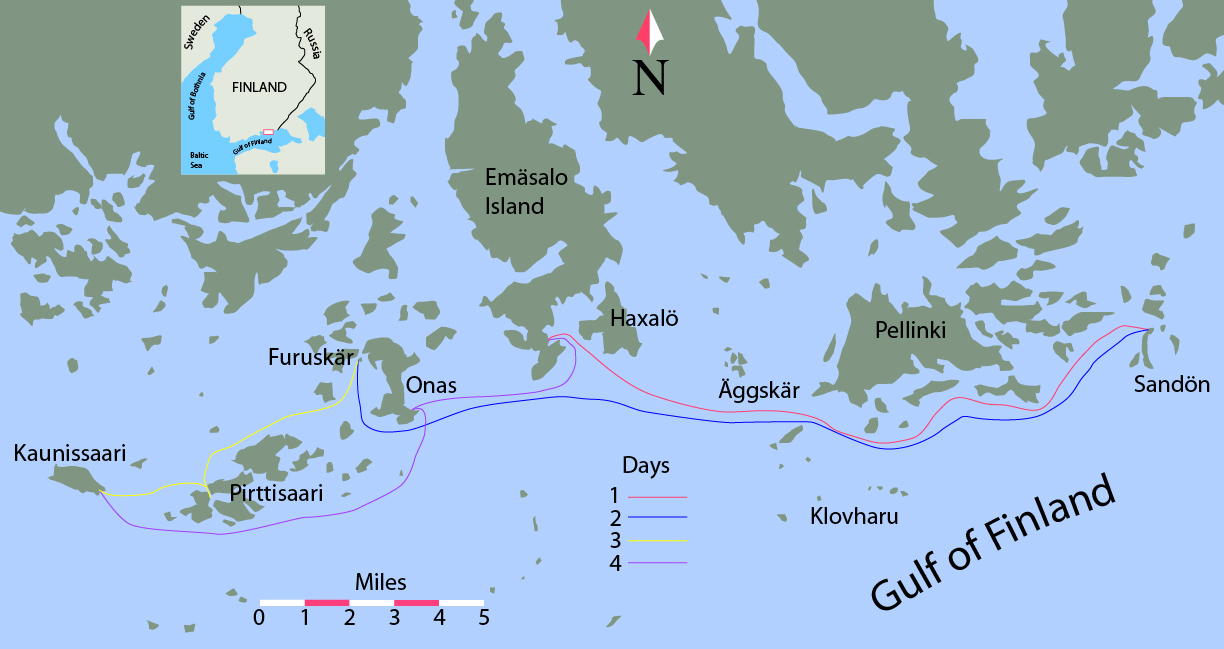
I walked along the esker that formed the island’s spine, following a narrow path that zigzagged through the heathland under tall pines. The island is narrow, and I caught glimpses of both shorelines through the colonnade of trees. Most of the islands of the archipelago are of solid granite, but Sandön (Sand Island) is a long, cusped crescent fringed with sand and stretching three-quarters of a mile from north to south. I continued my barefoot stroll along the eastern shoreline on the smooth sandy beach. The clouds made way for the sun, and a warm shaft of light gave the pine trees and cliffs a coppery glow.
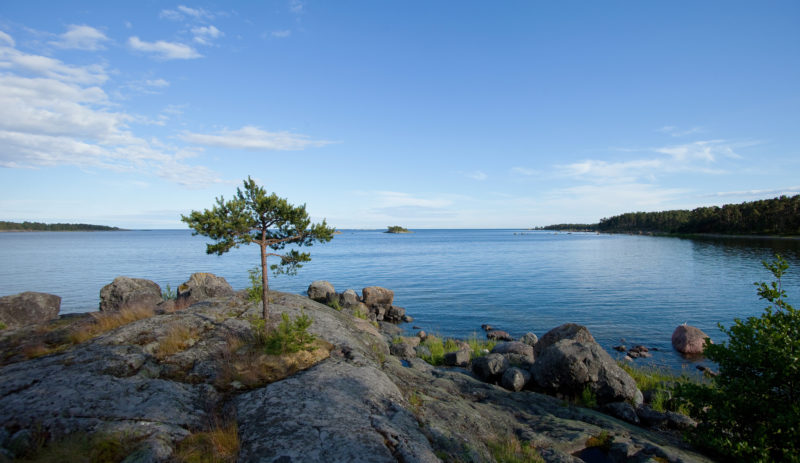
While I was camped at the northern tip Sandön, the skies cleared and I had one of the few sunny moments of my trip. In the distance to the south lies the open water of the Gulf of Finland and to the west, just out of view, lies one of the most beautiful sand beaches you can find in all of Finland.
The next day I woke to raindrops drumming gently and steadily on the tent. I was in no hurry to get up and waited for a while as the rain waned to a drizzle. When I shoved off, I paddled standing forward in the boat with one oar to get out of the shallow water and glided over a coffee-brown, rocky bottom. I lowered the centerboard, attached the rudder, and with a few pulls raised the lugsail. AANAR immediately picked up speed, sliding silently away from the shore and leaving nothing but ripples in the calm surface of the water. A man and a woman were walking on the beach near a small catamaran they’d pulled ashore. They waved to me and I waved back. I had noticed them yesterday evening camping a few hundred meters down the shoreline, but hadn’t approached them. This is typical of Finnish nature. We appreciate our country’s vast wild spaces, the thousands of lakes and islands, and respect the privacy they afford us.
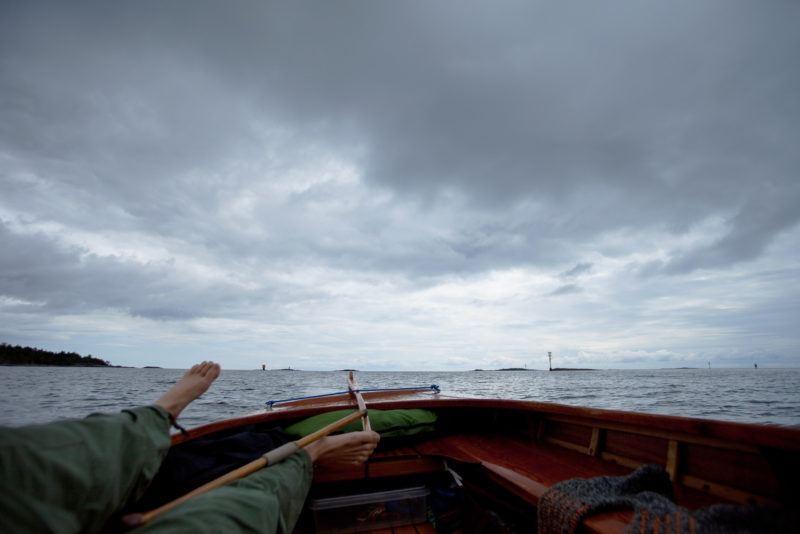
Taking a rest and steering with my toes, I sailed away from the small islands at the edge of the Gulf of Finland. On the horizon on the right is Klovharu, the small and remote islet where Tove Jansson and her companion spent their summers.
Some of my clothes were already wet from the rain, and the cold, damp air had gotten into my bones, so instead of sailing farther east I headed back west to a small island owned by the yachting club I belong to. The sauna there would warm me up. I sailed past a three-mile-long broken chain of islets and granite outcroppings at the edge of the Gulf of Finland. One of the islets is Klovharu, nothing more than a knoll of bare rock rising from the open sea. On this remote island artist, cartoonist, and creator of Moomins, Tove Jansson and her companion Tuulikki Pietilä spent summers for nearly 30 years. (Moomins are hippopotamus-like children’s-book characters whose popularity spread from Finland to all of Scandinavia, and the UK, Japan, and even the former USSR.) There are no trees on the island, only bare granite, rocks, and a small one-room cabin with a chimney in one corner. Tove and Tuulikki had a wooden rowboat with a small outboard, and fished for food whenever the wind allowed. When it was blowing hard they could not get off the island, but Klovharu was their refuge and their inspiration. They fell in love with the open sea, the abundant sunlight, and the storms that swept past their island from time to time.
As AANAR was gliding slowly in the calm reflecting sea, I was tempted to head for some of the small outer islands near Klovharu, but being surrounded by the open sea, there is always some swell, making landing tricky, especially when I’m on my own. I sailed instead to Äggskär, which has a harbor sheltered by two surrounding islands.
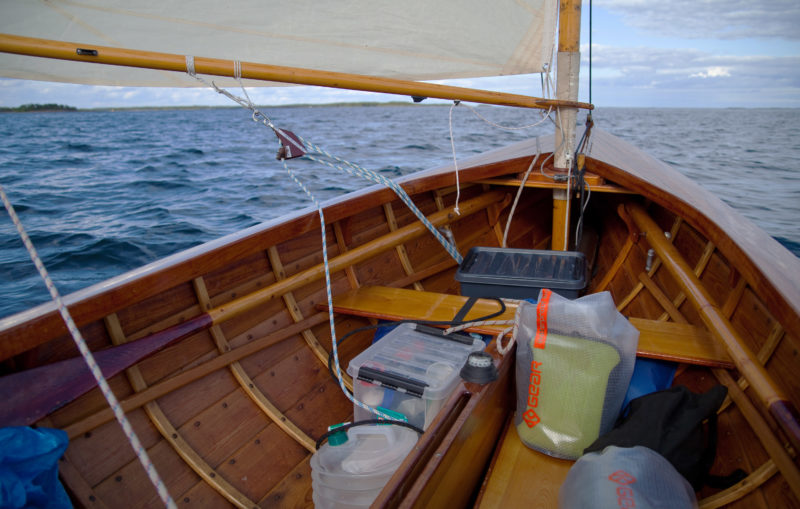
There is plenty of space in the boat for one man and camping gear. The dark grey box is for food and the transparent one is the kitchen containing a camp stove. Clothes are packed in watertight bags; sleeping bag and mat fit under the small foredeck.
Äggskär is a pine-forested island the size of few football fields; it sits at the center of a tight archipelago of five other islands. The bay between Äggskär and Långholmen to the east is littered with boulders; low slabs of rusty-colored granite bedrock rise from Äggskär’s eastern shoreline. After landing at the pier I grabbed my kitchen box and some food and walked to a firepit near the rocky shore. I cooked hotdogs over an open fire and brewed a strong latte with a moka pot. I usually take a refreshing dip in the sea whenever there is an opportunity, but I passed this time, still feeling chilled from sitting in the boat during the cool morning.
From Äggskär to Furuskär, the island owned by my yacht club, it was going to be 8 miles tacking upwind, so soon after lunch I left and raised sail. The wind was very light but gradually increased as I passed by the southernmost tip of Emäsalo Island. The sun was getting low, and I still had some tacking to do before I would reach Furuskär. When I arrived I was ready for the sauna. A private island with a sauna might sound like something fancy, but the sauna, typical of those in the area, is a very modest log building measuring only 9’ by 7’ with a tiny dressing room on other side. Inside the sauna there is a wood-burning stove and benches on one wall. The steel stove, streaked with rust, has a water tank attached to it, supplying hot water for washing. There are hundreds of thousands of these summer-cottage saunas along the coastline around the many numerous lakes of Finland. It is estimated that in all of Finland there are two million saunas.
I got the fire going and heated the sauna up to 175 degrees (80°C), and relaxed on the upper bench. I slowly soaked up the heat and gradually started throwing more and more water over the hot hissing stones, and a cloud of hot vapor gently curled down from the ceiling, making the humid air feel a whole lot hotter. The sauna was close by the shoreline, just a short walk down to sea for a refreshing swim. The combination of hot sauna and cooling effect of the water gave my body a rush and an instant feeling of deep relaxation and comfort. It was not so effective as it is during the winter, but good enough.
Warmed up and with dry clothes, I launched the next day and sailed farther west in a steady wind of 10 knots. I was going upwind and hiked out to keep AANAR going fast with a moderate heel. It is in conditions like these that I enjoy sailing the Coquina most. With my one hand on the helm and the other on the hard-pulling sheet, AANAR was briskly climbing up and down the gently sloping waves with water splashing hard against the lapstrake hull. The lugsail had a perfect full form and was driving us powerfully, and I had just enough weight on the rail to keep her from heeling too much.
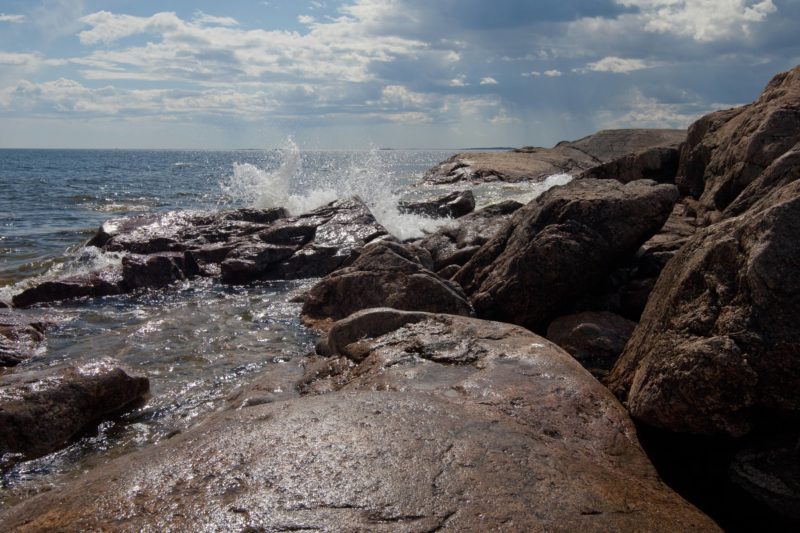
Kaunissaari means “Beautiful Island,” but much of its shoreline can be quite menacing where waves break on bare rocks and cliffs.
My destination for the night was Kaunissaari, a mile-long island some 5 or 6 miles to the west. With this moderate wind it would only take an hour and a half to get there, so I took a tack to the southeast and into the sheltered village bay of Pirttisaari, a former fishing village. The bay is protected from all directions, and has small piers, boathouses, and wooden villas with red, white, and yellow façades all around its shoreline. I strolled along a narrow path through the well-maintained gardens with rose bushes, colorful flower benches, and neatly mowed lawns stretching all the way to the shoreline. After passing a half a dozen villas, I continued deeper into the island; the narrow path turned into a wider sandy trail, where the alder and pine trees were taller and shading the narrow winding road.
I returned to AANAR, cast off from the dock, and raised sail again. The wind had died, so I found myself doing little more than drifting as I tried to get out of the bay and through the narrow channel. With a few painfully slow tacks I managed to struggle out of the channel. There was still a swell running from the wind earlier in the day, and AANAR was rolling in the waves with little speed, the sail and spars sagging and swinging from side to side. I could have taken the sail down and pulled out oars, but I decided to wait. In half an hour the wind picked up again, and I reached Kaunissaari after a couple of hours. I sailed in between the harbor’s twin curved breakwaters of mounded boulders. The 200-yard-long natural bay behind the breakwaters was crowded with boats and surrounded by alder trees hanging over the water. I made a smooth landing in one of the free spots on the dock with sail still up.
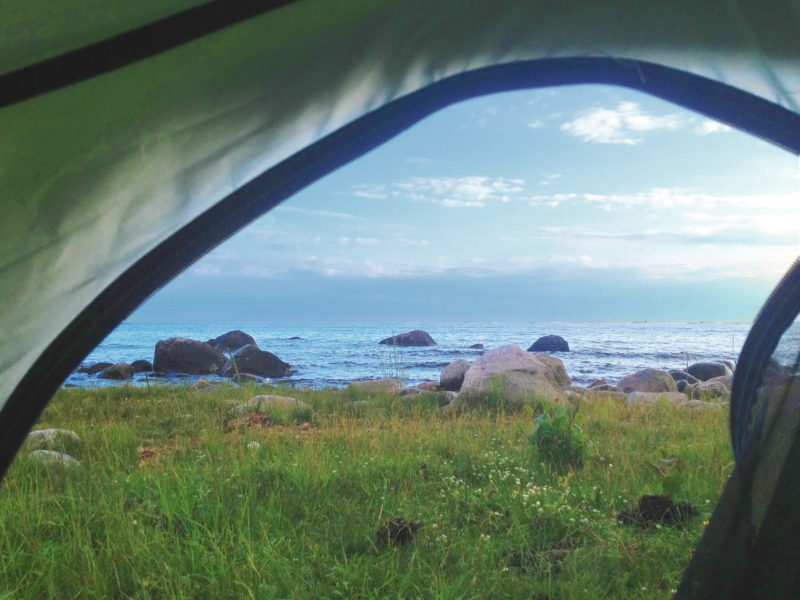
While all of the other boaters visiting Kaunissaari were stuck in the shadowed harbor, I had the best view all to myself just a short walk away.
A young couple with kids in a boat tied up next to me had come for the night in a classic Danish Coronet, a fiberglass day-cruiser motorboat with a small cabin. The kids were wondering where I sleep. I showed them my tent and then packed the camping gear into a bag and walked a few hundred yards along the south shore. I found a meadow of hay and flowers just 20 yards from the sea with more than enough room for my tent and an unobstructed view into the light blue vast Gulf of Finland. As the fading sun bathed the rocks and cliffs with amber light, I had a swim in the cool and clear water. I toweled dry and relished a cup of port wine sitting on the still-warm bare stone. I soon turned in for the night and fell asleep listening to the swell breaking into the rocky shore.
Rays of sun warming up the tent woke me up, so I packed my gear, and had breakfast and coffee on the pier. I took a 2-mile walk along the path going around the island. On the northern, more sheltered side of the island the dense spruce forest pushed up tight against the shore. The path was in deep shade and the only sunlight I could see was shining on the islands across the water to the north. I rounded the western part of the island and turned south, where serene meadows were surrounded with crooked alder trees and rugged cliffs that had been worn smooth by the last ice age. I saw a few tents and campsites, but they were well hidden behind the rocky knolls, bushes, and trees, so this part of the island, while popular, did not feel crowded.
This was the first clear day of the week, and as I set sail my eyes were overwhelmed by the brilliant light and the bright blue sky. The wind was nothing more than a gentle puff, the sea calm and reflecting, so I was able to take the outer route back to the southern tip of Emäsalo. AANAR was slipping gently eastward in a broad reach, making 3 knots. I tucked the tiller extension into a slot between the bench and the hull and left it locked there. Sitting in the middle of the boat facing the stern, I could steer by shifting my weigh slightly from one hip to the other. I sailed literally by the seat of my pants for half an hour.
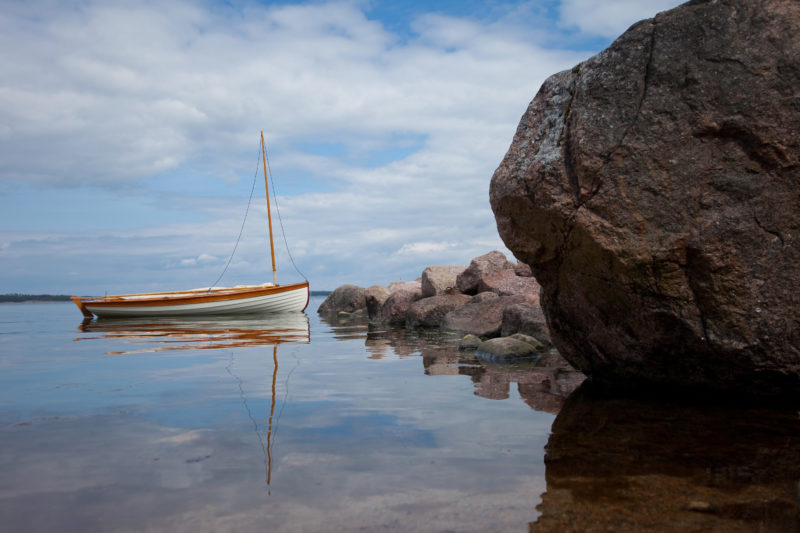
On my last day out I stopped for a lunch in the quiet lee of Onas island. A small natural harbor there is protected by a row of boulders.
Halfway home I turned north along the east shore of Onas Island and landed behind a natural breakwater of rocks. I was less than 3 miles from Emäsalo, and, in no hurry to end this trip, I would have a leisurely lunch before heading home. Twenty meters up a gentle slope from the beach there was a fire pit surrounded with rough-hewn wooden benches. Instead of fire I used my camp stove, and while waiting for a potful of potatoes to cook, I admired the bright mahogany sheerstrake and shining white curving hull of AANAR resting peacefully, tethered to the breakwater. To my right were white and yellow flowers rising between the rocks of a rugged shore and small alder trees with branches curving over the distant blue line of the horizon. My mind was clear and my spirit lifted by the serene views and the sight of a small boat so full of character. I was already planning a next venture, and would bring my kids to share in all this coast and this boat have to offer.![]()
Mats Vuorenjuuri is the father of three and an entrepreneur, making a living in graphic design, photography, and freelance writing. He has sailed his whole life and has restored wooden sailboats and motorboats. He currently owns a small open plywood motorboat, a traditional Finnish lapstrake racing rowing boat with sliding seats, and the Coquina.
If you have an interesting story to tell about your adventures with a small wooden boat, please email us a brief outline and a few photos.
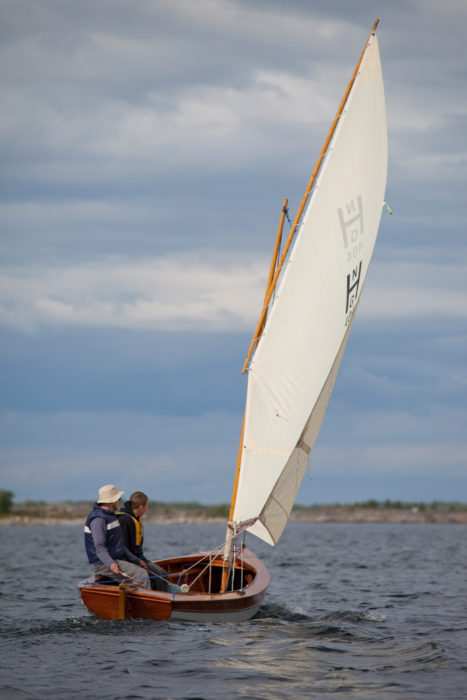
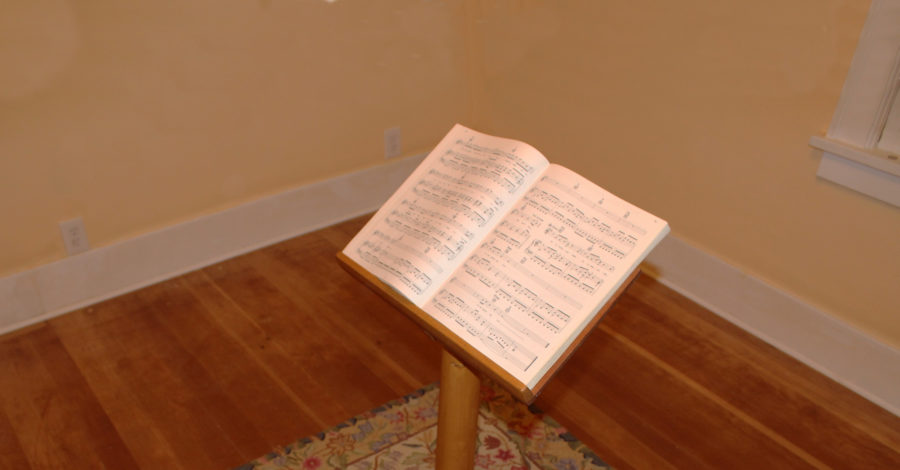
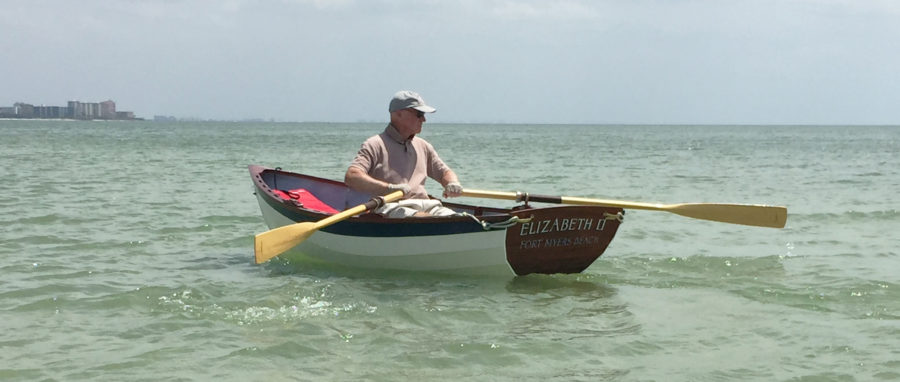
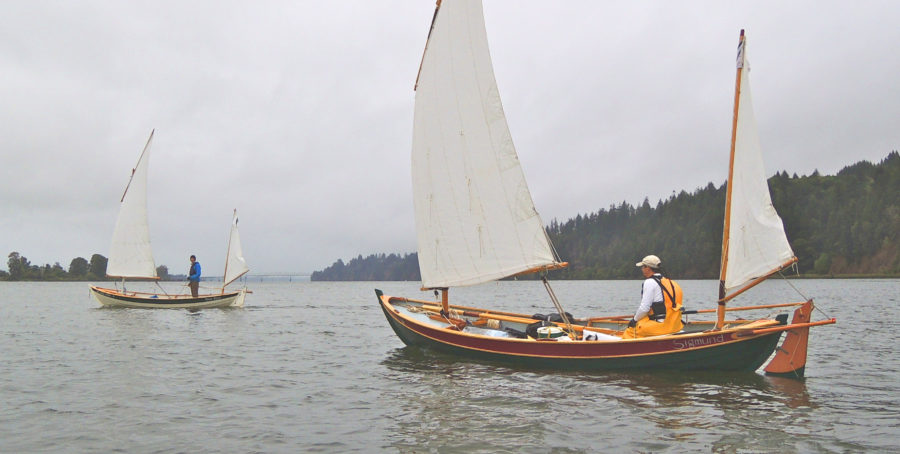
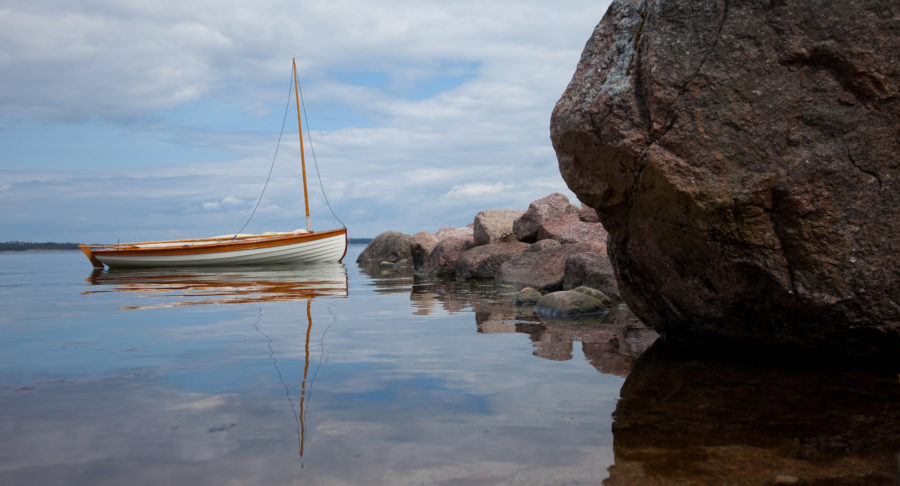
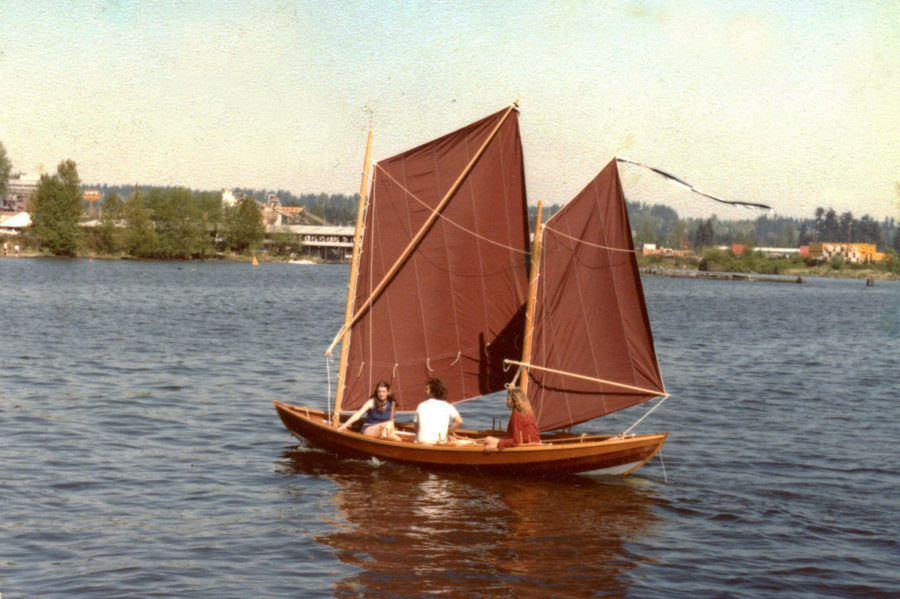
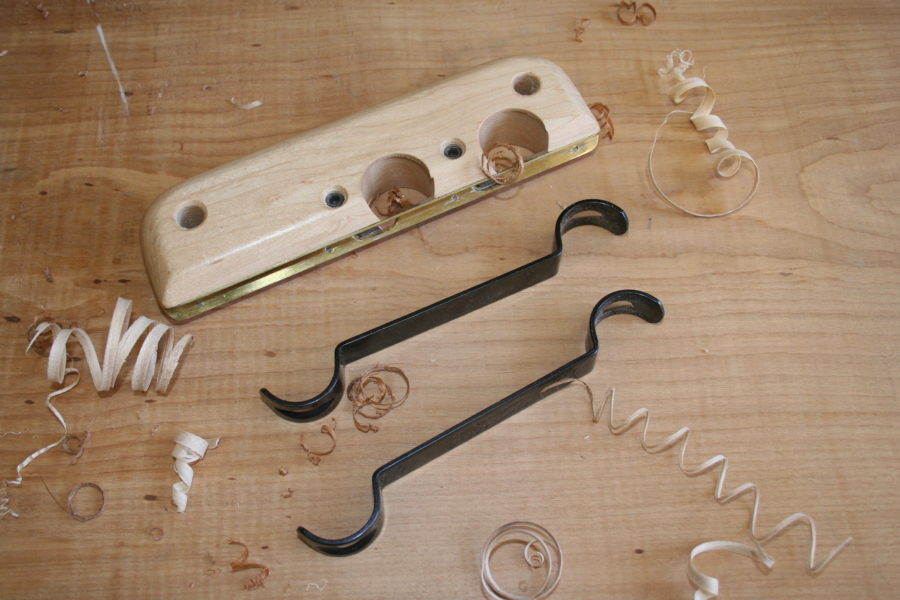
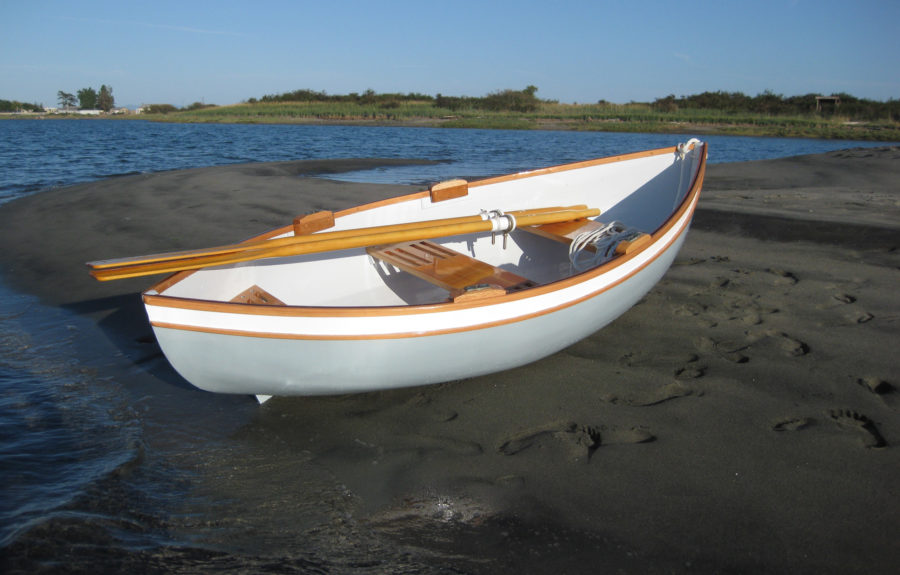
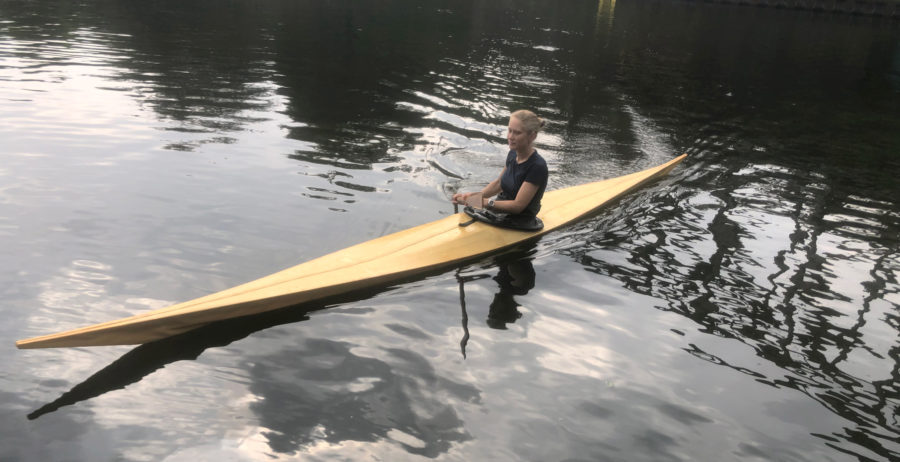
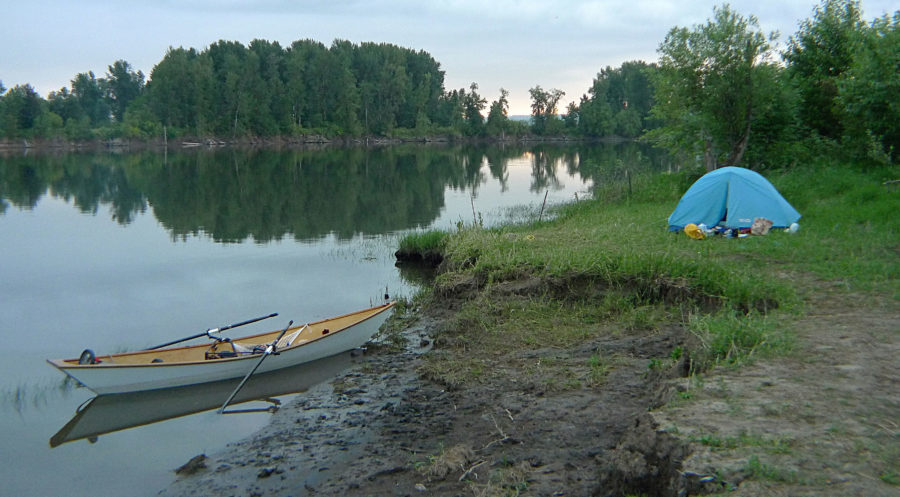
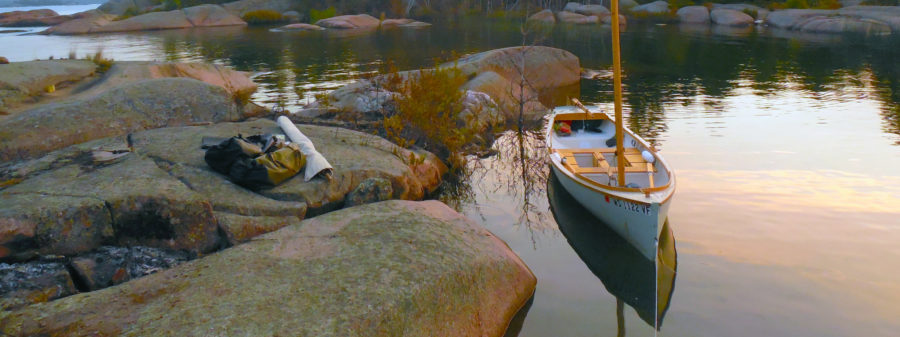
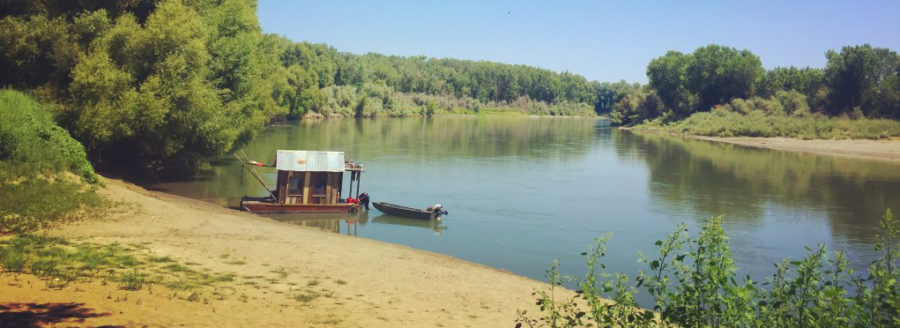
Lovely! And inspiring.
Do you have cell service that allows you to use GPS on your phone while sailing?
The coastal waters of the Gulf of Finland are pretty well marked with seamarks but we do have cell coverage and I sometimes use my phone’s GPS just to check position when I’m in unfamiliar waters.
Please, pictures and some information about your “traditional Finnish lapstrake racing rowing boat with sliding seats.”
My rowing boat is 6 meters long, very narrow, and has extremely pointy ends. It was originally designed and built for a rower and a helmsman taking turns rowing, but when I restored the boat I added a second rowing station. Boats like these have developed in the Saimaa Lake and Savo regions of Finland and there is an annual event, the Sulkava Rowing Race where hundreds of boats gather and race in singles, doubles, and traditional church-going boats with 8 or more rowers. The racing boats’ designs are traditional and have evolved during hundreds of years but the construction and gear are thoroughly modern. Ruud van Veelen of Puuvenepiste builds the fastest boats for this race, and his Saajuu 470 was reviewed in the August 2015 issue of Small Boats Monthly.
Thanks for the picture (great boat!), information, and links.